HONDA PRELUDE 2000 Owner's Manual (in English)
Manufacturer: HONDA, Model Year: 2000, Model line: PRELUDE, Model: HONDA PRELUDE 2000Pages: 293, PDF Size: 3.43 MB
Page 261 of 293
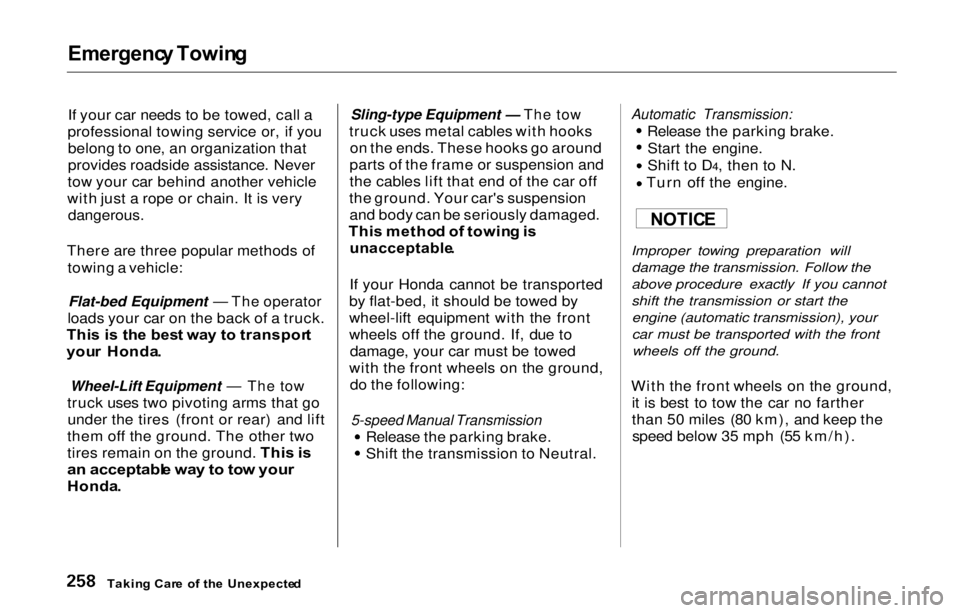
Emergency Towin g
If your car needs to be towed, call a
professional towing service or, if you belong to one, an organization that
provides roadside assistance. Never
tow your car behind another vehicle
with just a rope or chain. It is very
dangerous.
There are three popular methods of
towing a vehicle:
Flat-bed Equipment — The operator
loads your car on the back of a truck.
Thi s i s th e bes t wa y t o transpor t
you r Honda .
Wheel-Lift Equipment — The tow
truck uses two pivoting arms that go
under the tires (front or rear) and lift
them off the ground. The other two
tires remain on the ground. Thi s is
a n acceptabl e wa y t o to w you r
Honda .
Sling-type Equipment — The tow
truck uses metal cables with hooks
on the ends. These hooks go around
parts of the frame or suspension and
the cables lift that end of the car off
the ground. Your car's suspension and body can be seriously damaged.
Thi s metho d o f towin g is
unacceptable .
If your Honda cannot be transported
by flat-bed, it should be towed by
wheel-lift equipment with the front
wheels off the ground. If, due to damage, your car must be towed
with the front wheels on the ground, do the following:
5-speed Manual Transmission
Release the parking brake.
Shift the transmission to Neutral.
Automatic Transmission:
Release the parking brake.
Start the engine.
Shift to D4, then to N.
Turn off the engine.
Improper towing preparation will
damage the transmission. Follow the
above procedure exactly If you cannot
shift the transmission or start theengine (automatic transmission), your
car must be transported with the frontwheels off the ground.
With the front wheels on the ground, it is best to tow the car no farther
than 50 miles (80 km), and keep thespeed below 35 mph (55 km/h).
Takin g Car e o f th e Unexpecte d
NOTICE
Page 262 of 293
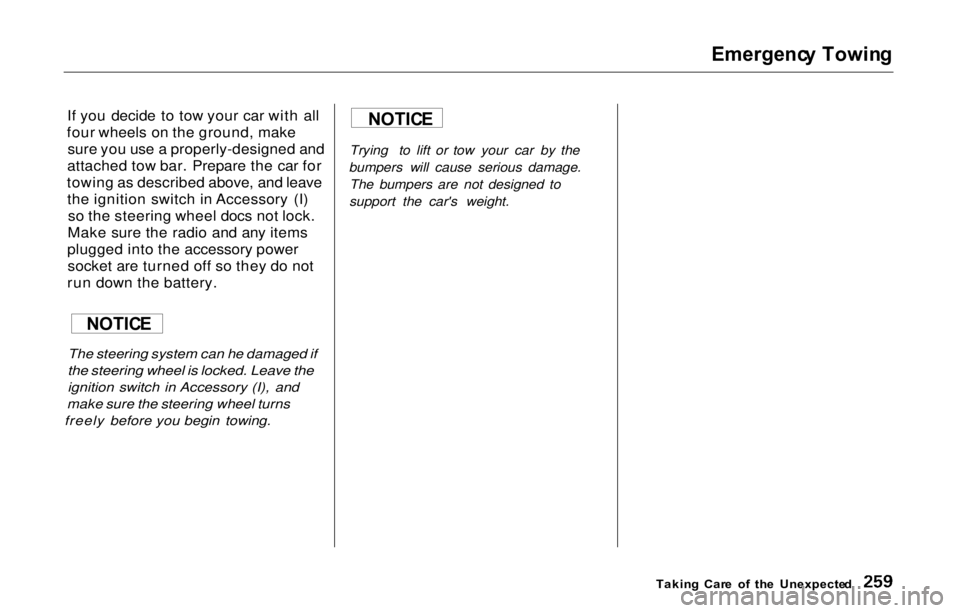
Emergenc
y Towin g
If you decide to tow your car with all
four wheels on the ground, make sure you use a properly-designed and
attached tow bar. Prepare the car for
towing as described above, and leave the ignition switch in Accessory (I) so the steering wheel docs not lock.
Make sure the radio and any items
plugged into the accessory power socket are turned off so they do not
run down the battery.
The steering system can he damaged if
the steering wheel is locked. Leave the
ignition switch in Accessory (I), and
make sure the steering wheel turns
freely before you begin towing.
Trying to lift or tow your car by the
bumpers will cause serious damage. The bumpers are not designed to
support the car's weight.
Taking Car e o f th e Unexpecte d
NOTIC
E
NOTIC E
Page 263 of 293

260
Page 264 of 293
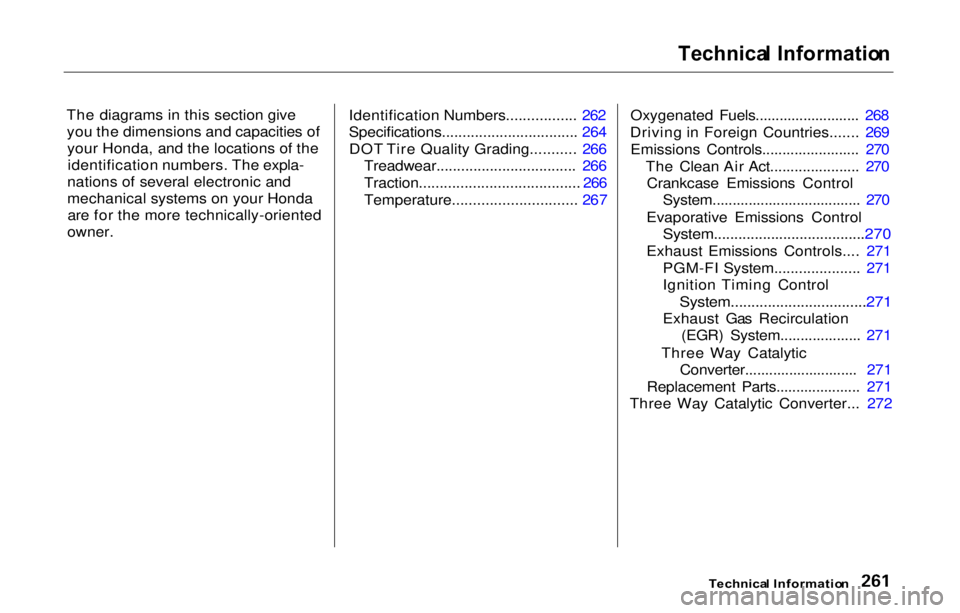
Technica
l Informatio n
The diagrams in this section give you the dimensions and capacities ofyour Honda, and the locations of theidentification numbers. The expla-
nations of several electronic and
mechanical systems on your Honda are for the more technically-oriented
owner. Identification Numbers................. 262
Specifications................................. 264
DOT Tire Quality Grading........... 266 Treadwear.................................. 266
Traction....................................... 266
Temperature.............................. 26
7
Oxygenated Fuels.......................... 268
Driving i
n Foreign Countries....... 269
Emissions Controls........................ 270 The Clean Air Act...................... 270Crankcase Emissions Control System..................................... 270
Evaporative Emissions Control
System.....................................270
Exhaust Emissions Controls.... 271 PGM-FI System..................... 271
Ignition Timing Control
System.................................271
Exhaust Gas Recirculation (EGR) System.................... 271
Three Way Catalytic Converter............................ 271
Replacement Parts..................... 271
Three Way Catalytic Converter... 272
Technical Informatio n
Page 265 of 293
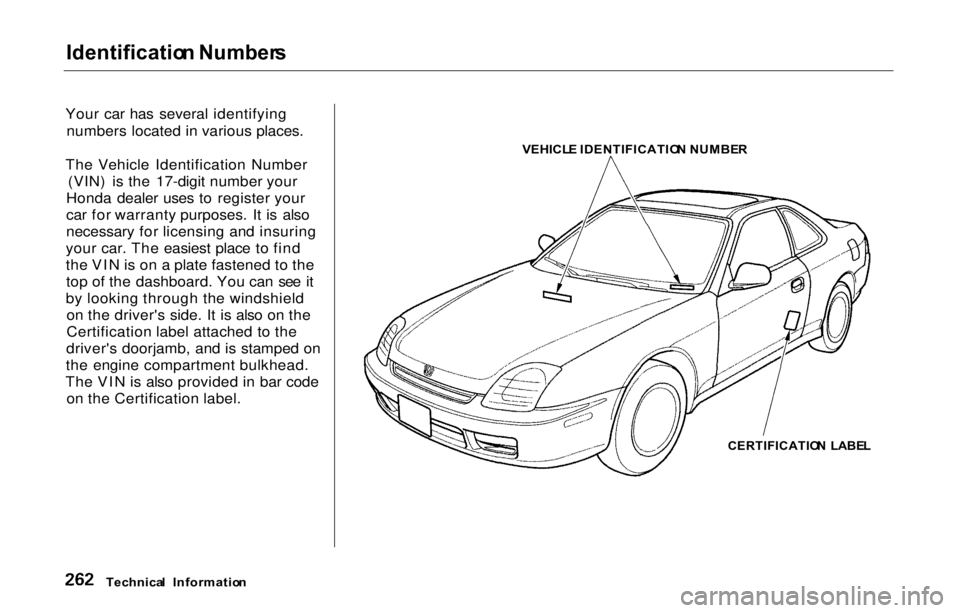
Identificatio
n Number s
Your car has several identifying numbers located in various places.
The Vehicle Identification Number (VIN) is the 17-digit number your
Honda dealer uses to register your
car for warranty purposes. It is also
necessary for licensing and insuring
your car. The easiest place to find
the VIN is on a plate fastened to the top of the dashboard. You can see it
by looking through the windshield on the driver's side. It is also on the
Certification label attached to the
driver's doorjamb, and is stamped on
the engine compartment bulkhead.
The VIN is also provided in bar code on the Certification label. VEHICL
E IDENTIFICATIO N NUMBE R
CERTIFICATIO N LABE L
Technica l Informatio n
Page 266 of 293
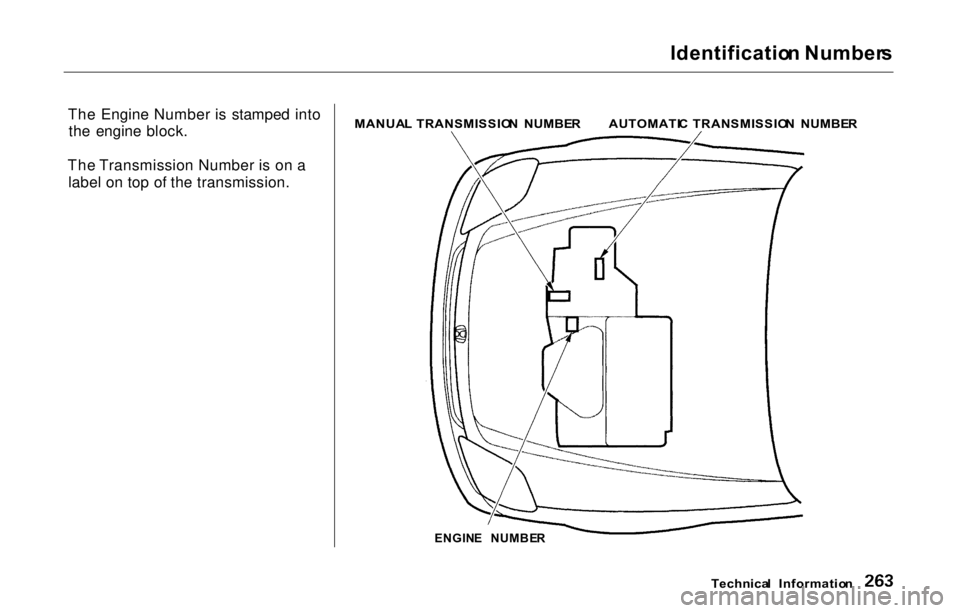
Identificatio
n Number s
The Engine Number is stamped into the engine block.
The Transmission Number is on a label on top of the transmission.
MANUA
L TRANSMISSIO N NUMBE R
ENGIN E NUMBE R
Technical Informatio n
AUTOMATI
C TRANSMISSIO N NUMBE R
Page 267 of 293
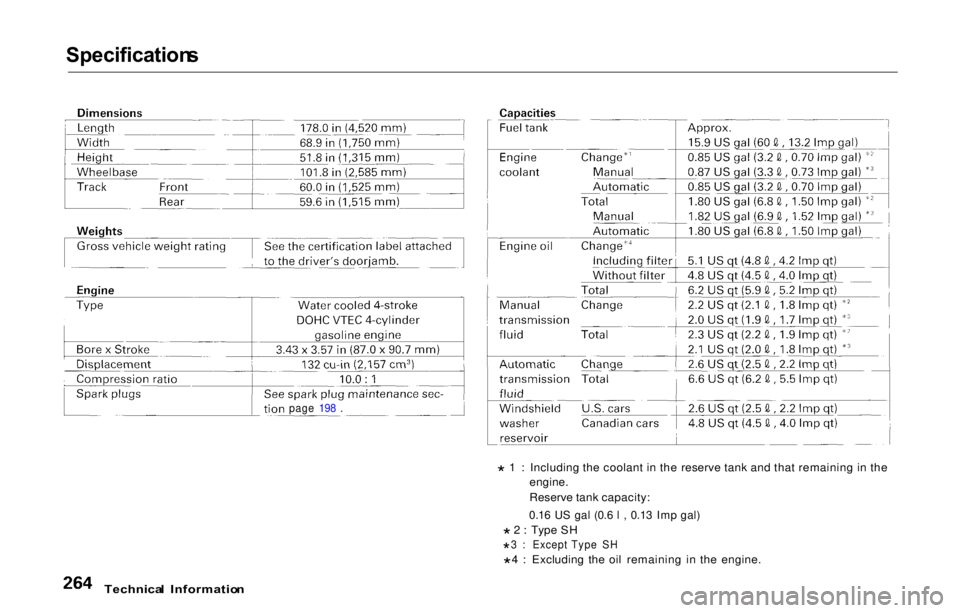
Specifications
* 1 : Including the coolant in the reserve tank and that remaining in the
engine.
Reserve tank capacity:
0.16 US gal (0.6 l , 0.13 Imp gal)
*2: Type SH
*3 : Except Type SH
*4 : Excluding the oil remaining in the engine.
Technical Informatio n
page 198 .
Page 268 of 293
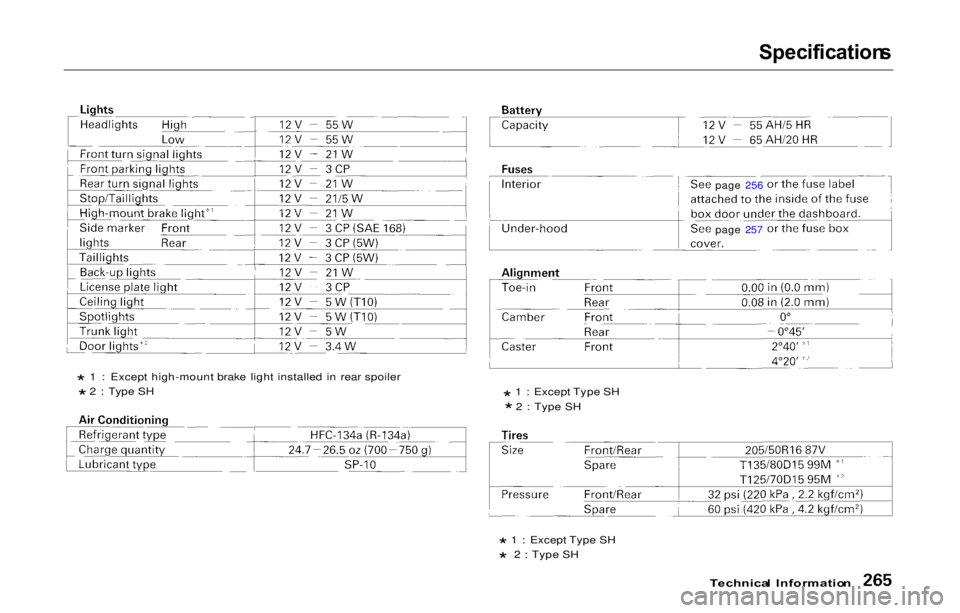
Specification
s
* 1 : Except Type SH
* 2 : Type SH
Technical Informatio n
page 256
page 257
* 1 : Except high-mount brake light installed in rear spoiler
* 2 : Type SH
* 1 : Except Type SH
* 2 : Type SH
Page 269 of 293
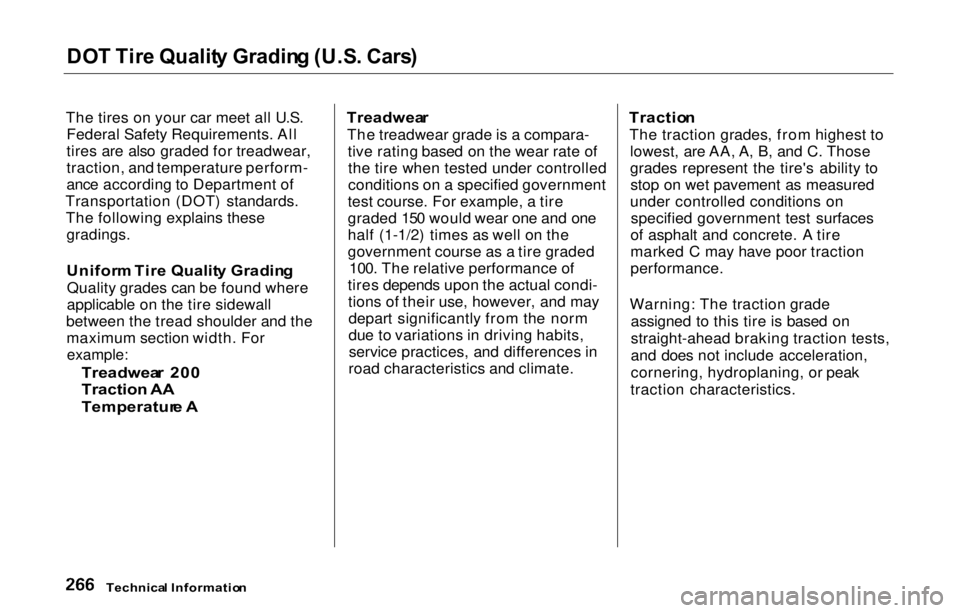
DO
T Tir e Qualit y Gradin g (U.S . Cars )
The tires on your car meet all U.S. Federal Safety Requirements. All
tires are also graded for treadwear,
traction, and temperature perform-
ance according to Department of
Transportation (DOT) standards. The following explains these
gradings.
Unifor m Tir e Qualit y Gradin g
Quality grades can be found where
applicable on the tire sidewall
between the tread shoulder and the maximum section width. For
example:
Treadwea r 20 0
Traction AA
Temperatur e A
Treadwea
r
The treadwear grade
is a compara-
tive rating based on the wear rate of the tire when tested under controlled
conditions on a specified government
test course. For example, a tire
graded 150 would wear one and one
half (1-1/2) times as well on the
government course as a tire graded 100. The relative performance of
tires depends upon the actual condi- tions of their use, however, and maydepart significantly from the norm
due to variations in driving habits,service practices, and differences in
road characteristics and climate.
Tractio
n
The traction grades, from highest to lowest, are AA, A, B, and C. Those
grades represent the tire's ability tostop on wet pavement as measured
under controlled conditions on specified government test surfaces
of asphalt and concrete. A tire
marked C may have poor traction
performance.
Warning: The traction grade assigned to this tire is based on
straight-ahead braking traction tests,
and does not include acceleration,
cornering, hydroplaning, or peak
traction characteristics.
Technica l Informatio n
Page 270 of 293

DO
T Tir e Qualit y Gradin g (U.S . Cars )
Temperatur e
The temperature grades are A (the highest), B, and C, representing the
tire's resistance to the generation of
heat and its ability to dissipate heat
when tested under controlled conditions on a specified indoor
laboratory test wheel. Sustained high
temperature can cause the material of the tire to degenerate and reduce
tire life, and excessive temperature can lead to sudden tire failure. The
grade C corresponds to a level of
performance which all passenger car
tires must meet under the Federal Motor Vehicle Safety Standard No. 109. Grades B and A represent
higher levels of performance on the
laboratory test wheel than the
minimum required by law. Warning: The temperature grade for
this tire is established for a tire thatis properly inflated and not over-
loaded. Excessive speed, underinfla-
tion, or excessive loading either separately or in combination, can
cause heat build-up and possible tire
failure.
Technical Informatio n